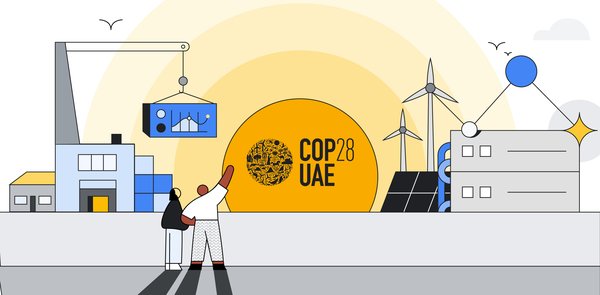As the effects of climate change play out before our eyes, the need for climate action has never been more urgent. It’s not just the global public advocating for change. With climate-related disasters costing the world economy more than $500 billion a year, business leaders are also focused on taking climate action. CEOs rank sustainability a top priority, 37% more frequently in 2022 than in the previous year.
Google has set an ambitious goal to reach net-zero emissions across our operations and value chain by 2023, and we’re committed to working with our customers and partners to develop new sustainability solutions and help apply technology like artificial intelligence (AI) to support climate efforts.
For example, we launched the Google Cloud Ready Sustainability program last year to help customers identify and deploy sustainability solutions developed by our ecosystem of partners. The program spotlights partner solutions built on Google Cloud and that leverage specific climate and ESG-related domain expertise alongside capabilities in AI and earth observation from Google Cloud. These important solutions are supporting customers across important areas like digital sustainability, ESG performance management, sustainable sourcing, fleet electrification, energy optimization, and green financing.
Using AI to help fund a decarbonized economy
Google Cloud Ready Sustainability partner ESG Book gives financial markets access to the information to understand companies’ sustainability practices, enabling investors to make informed investment decisions.
ESG Book is utilizing Google Cloud AI to help customers make sense of this vast volume of data. For instance, Google Cloud Document AI automates components of the workflow of searching for documents containing relevant ESG information, parsing those documents for pertinent data, then extracting that data and using it to populate structured datasets that can be sold to investors to inform their investment decisions. Using AI to automate its workflow in this way, ESG Book believes it is possible to improve efficiency on manual data collection efforts by around 50%, freeing its team to develop more products to help decarbonize the economy.
One such product is its news sentiment analysis tool, which uses AI to collate, summarize, and analyze the sentiment of millions of news articles to gain insights into companies’ sustainability and environmental practices beyond those covered by the businesses’ own reporting. By converting this sentiment into a score, ESG Book’s AI workflow helps create an augmented rating for each company, providing an outside-in view, enabling financial markets to invest in the most sustainable businesses.
Helping companies reduce their carbon footprint with granular reporting
Watershed, another Google Cloud Ready Sustainability partner, is an enterprise climate platform that helps businesses reduce their emissions and remove millions of tons of carbon from the atmosphere. With Google Cloud, Watershed is able to work at scale to bring granular, auditable sustainability reporting into businesses’ everyday decision making, enabling emissions-reduction programs such as decarbonizing supply chains to build products with a low-carbon footprint, like Everlane’s sneakers.
In order to provide this level of detail on supply-chain emissions, Watershed’s models depend on the most up-to-date data for every part of the process. If you put in an outdated figure for the energy needed to manufacture a certain sweater, for example, the modeled figure for the entire supply chain could be distorted. So Watershed is experimenting with using AI to measure, collect, and update data more frequently, as well as synthesizing the data to look for trends and patterns to inform its modeling, ensuring its emissions reporting is as accurate as possible.
Redefining emissions reporting with generative AI
Both Watershed and ESG Book are especially excited about the potential of generative AI (gen AI) not only to further streamline their processes, but to offer new products and services that will transform the ways customers interact with their carbon emissions data. Watershed’s vision of gen AI is to help transform a vast amount of unstructured, text-based data in corporations’ supply chains into a format that can be used in its modeling, improving the efficiency of its internal processes. Meanwhile, offering customers the ability to use large language models (LLMs), trained on relevant sustainability datasets, to write their ESG reports would save businesses significant amounts of time, which they could use to focus on working towards sustainability targets.
ESG Book already uses AI to estimate corporate GHG emissions, but is exploring how it could use gen AI to enable investors such as asset managers and investment banks to interrogate its vast datasets in entirely new ways. Right now, the screening and visualization tools ESG Book offers are highly structured. But with gen AI, ESG Book plans to enable customers to use unstructured, natural language questions to mine its data in unlimited ways, unearthing insights such as trend analysis, heatmaps, correlations, or highly specific requests that are currently difficult to scale. ESG Book hopes to empower its clients to use its data to get unprecedented insights into companies’ sustainability practices, enabling an even more targeted flow of investment to companies preparing for a decarbonized future.
Partners and platforms for a growing challenge
The use of AI in helping businesses operate more sustainably is still in its early stages, but as the experience of Watershed and ESG Book already shows, the potential is great for partner-driven AI solutions to transform the ways businesses think about and act on environmental sustainability. With both environmental and economic pressures, AI has an important role to play in helping drive a carbon-free future. Given the scale of the challenge we face, that is something worth getting excited about.
We’re blogging throughout COP28; follow along here.
Cloud BlogRead More


